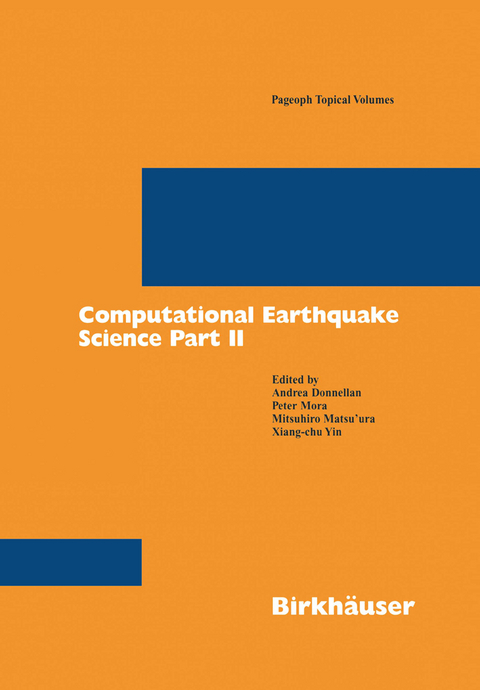
Computational Earthquake Science Part II
Springer Basel (Verlag)
978-3-7643-7143-2 (ISBN)
Exciting developments in earthquake science have benefited from new observations, improved computational technologies, and improved modeling capabilities. Designing models of the earthquake generation process is a grand scientific challenge due to the complexity of phenomena and range of scales involved from microscopic to global. Such models provide powerful new tools for the study of earthquake precursory phenomena and the earthquake cycle.
Through workshops, collaborations and publications, the APEC Cooperation for Earthquake Simulations (ACES) aims to develop realistic supercomputer simulation models for the complete earthquake generation process, thus providing a "virtual laboratory" to probe earthquake behavior.
Part II of the book embraces dynamic rupture and wave propagation, computational environment and algorithms, data assimilation and understanding, and applications of models to earthquakes. This part also contains articles on the computational approaches and challenges of constructing earthquake models.
A. Dynamic Rupture and Wave Propagation.- Guided Waves from Sources Outside Faults: An Indication for Shallow Fault Zone Structure?.- On the Effects of Non-planar Geometry for Blind Thrust Faults on Strong Ground Motion.- Which Dynamic Rupture Parameters Can Be Estimated from Strong Ground Motion and Geodetic Data?.- Numerical Simulations of Large Earthquakes: Dynamic Rupture Propagation on Heterogeneous Faults.- Finite-element Simulation of Seismic Ground Motion with a Voxel Mesh.- MHD Dynamo Simulation Using the GeoFEM Platform: Comparison with a Spectral Method.- B. Computational Environment and Algorithms.- A Wavelet Toolkit for Visualization and Analysis of Large Data Sets in Earthquake Research.- Role of Wavelets in the Physical and Statistical Modelling of Complex Geological Processes.- Parallel Visualization of Large-scale Unstructured Geophysical Data for the Earth Simulator.- A Parallel Implementation of the Lattice Solid Model for the Simulation of Rock Mechanics and Earthquake Dynamics.- C. Data Assimilation and Understanding.- Spatio-temporal Scanning and Statistical Test of the Accelerating Moment Release (AMR) Model Using Australian Earthquake Data.- Assimilation of Paleoseismic Data for Earthquake Simulation.- D. Model Applications.- On the Possibility of Elastic Strain Localisation in a Fault.- Interplate Coupling in the Kanto District, Central Japan, and the Boso Peninsula Silent Earthquake in May 1996.- Evidence of Strain Partitioning Between the Sierra Madre Fault and the Los Angeles Basin, Southern California from Numerical Models.- Spatial and Temporal Variation of LURR and its Implication for the Tendency of Earthquake Occurrence in Southern California.- Anomalous Seismicity and Accelerating Moment Release Preceding the 2001 and 2002 Earthquakes in Northern Baja California, Mexico.- A Damage Mechanics Model for Aftershocks.- Revisiting the Tidal Activation of Seismicity with a Damage Mechanics and Friction Point of View.- Load-Unload Response Ratio (LURR), Accelerating Moment/Energy Release (AM/ER) and State Vector Saltation as Precursors to Failure of Rock Specimens.- A 3-D Quasi-static Model for a Variety of Slip Behaviors on a Subduction Fault.- Simple Spring-mass Model Simulation of Earthquake Cycle along the Nankai Trough in Southwest Japan.- Emergent Anisotropy and Flow Alignment in Viscous Rock.
| Erscheint lt. Verlag | 22.11.2004 |
|---|---|
| Reihe/Serie | Pageoph Topical Volumes |
| Zusatzinfo | VIII, 348 p. 78 illus., 19 illus. in color. |
| Verlagsort | Basel |
| Sprache | englisch |
| Maße | 170 x 244 mm |
| Gewicht | 695 g |
| Themenwelt | Naturwissenschaften ► Geowissenschaften ► Geologie |
| Naturwissenschaften ► Geowissenschaften ► Geophysik | |
| Schlagworte | aftershock • assimilation • Earthquake • Energy • Environment • Erdbeben • Fault • fault zone • Geophysics • Modeling • Modelling • Research • Rock Mechanics • Seismic • subduction |
| ISBN-10 | 3-7643-7143-9 / 3764371439 |
| ISBN-13 | 978-3-7643-7143-2 / 9783764371432 |
| Zustand | Neuware |
| Haben Sie eine Frage zum Produkt? |
aus dem Bereich


